 |
 |
 |
| |
Impact of Drug Therapy and Co-Morbidities on the Development of Renal Impairment in HIV-Infected Patients: Results of a Large Retrospective Database Study
|
| |
| |
Reported by Jules Levin
IAC Mexico City Aug 3-8, 2008
Rawlings MK1, Klein J1, Klingler ET1, Queen E1, Rogers L1, Yau LH2, Pappa KA2, and Pakes GE2
for the COL109413 Study Team
1AIDS Arms Peabody Health Clinic, Dallas, TX, USA; 2GlaxoSmithKline, Research Triangle Park, NC, USA
AUTHOR CONCLUSIONS
This retrospective database analysis of medical records from a cohort of 323 HIV+ pts exposed to ART for ≥1 yr showed that the only significant
predictors of GFR decrease >25% from BL were:
-- time-on-study
-- hypertension
-- weight, and
-- age
This study did not find use of TDF or any other individual ART
agent to increase the risk of GFR decrease >25% from BL
AUTHOR DISCUSSION
In this retrospective database study, no significant difference was observed between TDF-treated and non-TDF-treated pts in time from study BL to occurrence of a GFR ↓ by 25% below BL.
Time-on-study, hypertension, weight, and age were the only significant predictors of GFR ↓ by 25% below BL.
Tordato et al13 similarly reported in a comparable sized population (n=316), that older age, not type of HAART, was associated with reduced GFR. However, unlike our study, Tordato's study showed female gender and differences between nadir and current CD4 counts to be linked with GFR decrease.
Over a mean 20-month follow-up period, Madeddu et al14 found in 354 TDF-treated HIV+ patients (67% men, mean age, 40 yrs, mean CD4+ ct 363 cells/mm3), that nephrotoxicity occurred more frequently in males and those who were HCV-coinfected, in CDC stage C, or with low CD4 counts. We did not see a relationship between HCV and GFR decrease.
F. Wolf et al15 found over a median monitoring period of 22 months that 25% of 500 TDF-treated HIV+ patients developed mild renal impairment compared to 21% of 100 non-TDF-treated control patients. Many of the patients (41%) with reduced creatinine clearance while on TDF had pre-existing kidney impairment. Most (72%) of the TDF-treated patients were also taking other drugs that could potentially cause kidney toxicity, compared with just 12% in the TDF-sparing group.
Our study was unique in that 61% of the data came from black HIV+ patients, a population at 12-fold higher risk for end-stage renal disease compared with the age- and race-adjusted national rate.16
In summary, our study supports the idea that age, hypertension and weight are predictors of GFR ↓ by 25% below BL. Within a population that is at significant risk for renal impairment, antiretroviral therapy was not predictive. This may in part be related to the particular renal function endpoint we chose for assessment. Our study population had a relatively high mean BL GFR (≥114 mL/min), potentially lowering the risk for TDF-associated renal toxicity.15 Differences in our results from other studies also might have been attributable to between-study differences in
rates of other types of co-morbidities or in types of co-administered drugs used by patients. Lastly, our study design had limitations that may have led to results that are different from those observed in other studies. First, we evaluated a relatively small population. And, second, our study did not have a randomized, controlled design in which patients were randomized to TDF- or non-TDF-containing arms and started on therapy at the same time.
BACKGROUND
Both HIV and its treatment are documented to increase nephrotoxicity risk in HIV+ patients.1-6
While some studies have suggested ART-associated renal failure with tenofovir disoproxil fumarate (TDF), few have looked at this in African-American HIV+ patients.7-12
Most studies to date have used the Cockcroft-Gault (CG) method of calculating GFR, which may be more inaccurate than the Modification of Diet in Renal Disease (MDRD) method, which factors in body-surface area and has an adjustment factor for African-American race.
The culpability of any antiretroviral treatment in the development of renal function decline must factor in all co-morbidities and non-HIV-related drug therapies patients are receiving.
The purpose of this retrospective database study is to compare the relative frequency of renal impairment, as defined as CG- and MDRD-calculated GFR reduction >25% from baseline (BL), and time from treatment initiation until appearance of renal impairment. The effect of demographics, HIV disease characteristics, and co-morbidities on renal impairment rates were also assessed.
METHODS
Study Design
Phase IV retrospective, single-center, electronic database study
Review of medical records of 691 HIV+ pts treated at the AIDS Arms Peabody Health Clinic (Dallas, TX) and followed for up to 4 yrs (2003-2006)
Analysis of data from only HAART-treated patients monitored continuously at the center for ≥1 year
Comparison of disease/Tx characteristics of pts whose GFR decreased >25% from BL with those with no GFR delta
GFR evaluated by both MDRD and Cockcroft-Gault (CG) methods
Data Collected
--Demographics, including age, gender, race/ethnicity, wt
--Labs, including VL, CD4 ct, serum creatinine
--Co-morbidities (HTN, DM, Hep C, Hep B)
--HAART drugs received, with start, stop, and delta dates
--Non-HAART drugs received, with start, stop, and delta dates
--Medication adherence via prescription refill records
Study Endpoints
Time from study BL-to-event (GFR ↓ >25% from BL) in TDF-txed vs non-TDF-txed pts
No. of pts who converted from NKF-defined mild to mod renal impt (GFR 60-89 to 30-59 mL/min), or from mod to severe renal impt (GFR 30-59 to 15-29 mL/min)
Effect of co-morbidities on time to GFR ↓ >25% from BL
Statistical Analysis
In HAART-treated patients monitored continuously at the center for ≥1 year, proportional hazards models were used to investigate an association of calculated GFR decrease >25% from BL ("renal
impairment") with the following:
1.demographic and baseline variables;
2.use of different antiretroviral agents;
3.certain co-morbidities (hypertension, diabetes mellitus, hepatitis C infection, hepatitis B infection);
4.time on ART; and
5.time over which patients were monitored at the clinic (time-on-study).
Significant covariates were selected into the model using the stepwise selection method
Patient Characteristics
323 patients treated for ≥1y were available for evaluation (see tables)
Most of the patients were males (82%) and black (61%)
Mean age was 37.9y; mean weight was 75.4 kg
About one-third were HCV+ (34%) and 6% were HBV+
29% were hypertensive and 3% diabetic
52% had been TDF-treated and 48% non-TDF-treated
Mean BL MDRD-calculated GFR was 114.5 mL/min/1.73m2; and mean CG calculated GFR was 120.6 mL/min/1.73m2
Mean time-on-study was 979.9d (2.7y)
RESULTS
Table 1. BL Characteristics of ART-Exposed Patients with
≥1 Year on Study
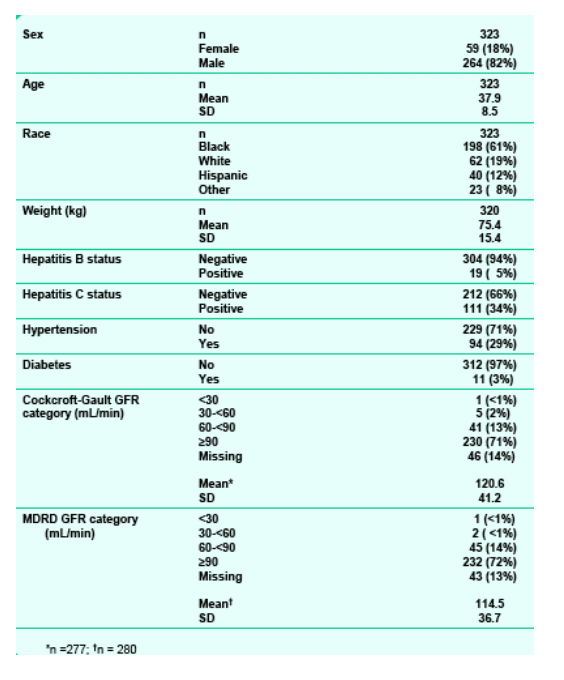
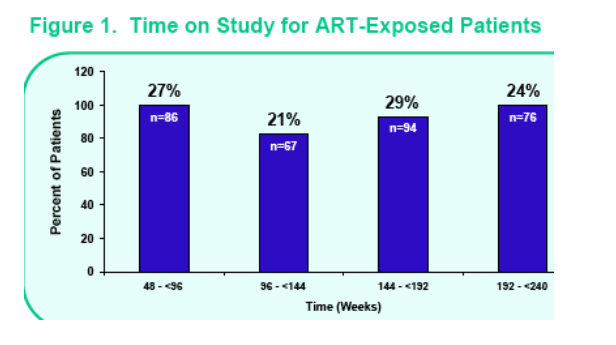
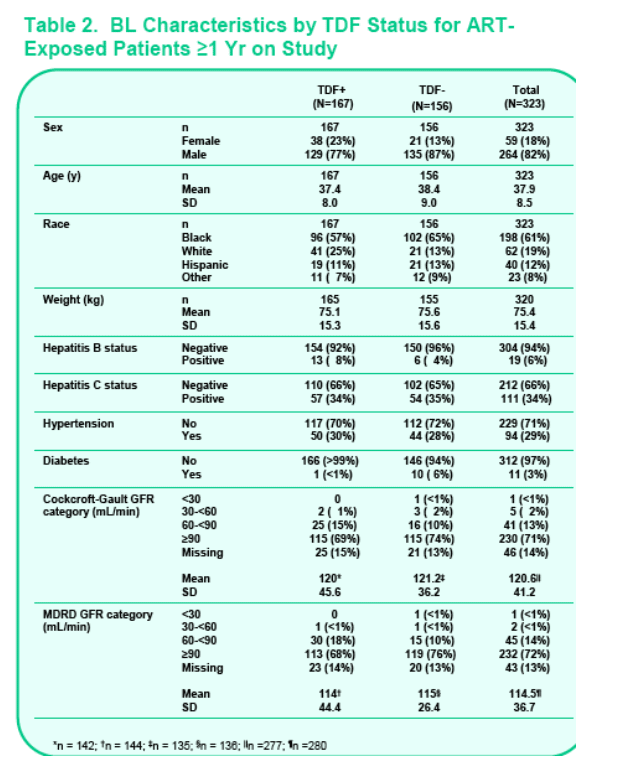
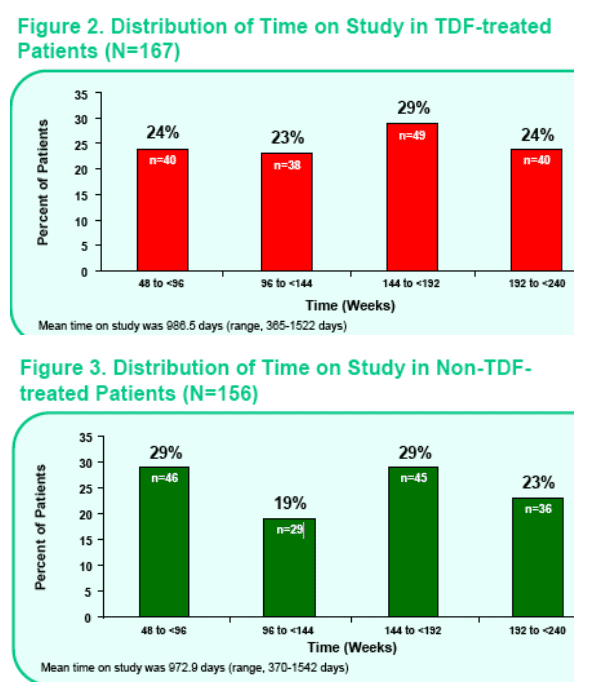
Using the CG GFR, age, weight, and time on study were found to significantly predict a >25% decline from BL in GFR (Table 4)
--For each year increase in age at BL, the hazard of having >25% decline from BL in CG GFR increases by 3.9%
--For each unit increase in weight, the hazard of having >25% decline from BL in CG GFR decreases by 1%
--For each additional day in the study, the hazard of having >25% decline from BL in CG GFR decreases by 0.1%
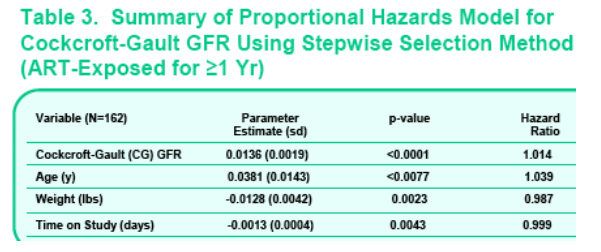
Using the MDRD GFR, time on study and hypertension status at BL significantly predict a >25% decline from BL in GFR (Table 5)
--For each additional day in the study, the hazard of having >25% decline from BL in MDRD GFR decreases by 0.1% (similar results as in the CC GFR)
--Patients with hypertension at BL are 1.7 times more likely to have >25% decline from BL in MDRD GFR than those who were not hypertensive at BL
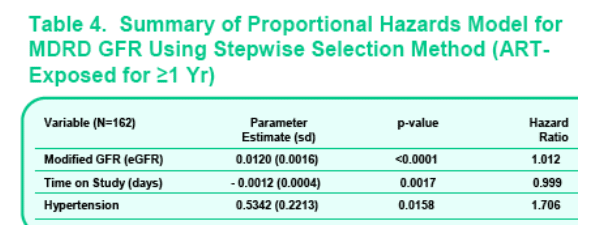
Prevalence and Predictors of Renal Insufficiency Among HIV-infected Patients in the Study to Understand the Natural History of HIV/AIDS in the Era of Effective Therapy
ET Overton1, K Mondy1, L Conley2, T Bush2, F Rhame3, K Lichtenstein4, S Cu-Uvin5, M Kojic5, K Wood6, C Vellozzi2, and JT Brooks2
ABSTRACT
Background: Renal disease remains an important complication of HIV and may complicate treatment with certain antiretrovirals.
Methods: The SUN Study prospectively follows 700 HIV-infected patients in 4 US cities. Clinical, behavioral, and fasting laboratory data were obtained at baseline. Significant factors identified using univariate analysis were analyzed by multivariate logistic regression to identify independent predictors of glomerular filtration rate (GFR) <90 mL/min/1.73m2. GFR was determined using the simplified modification of diet in renal disease (sMDRD) equation. Odds ratios for GFR <90 mL/min/1.73m2 were based on median values.
Results: Among 671 subjects with available data, the mean age was 41 years, 24% were women, 30% were African American, mean body mass index (BMI) was 25.5 kg/m2, 77% of subjects were on HAART, median CD4 cell count (CD4) was 452 cell/mL, 73% had HIV RNA (VL) < 400 copies/mL, 21% had hypertension (HTN), and 4% had diabetes. Despite low prevalence of chronic renal disease (3% with GFR <60 mL/min/1.73m2), proteinuria (10%), and glucosuria (1%), 40% had GFR <90 mL/min/1.73m2. Using multivariate analyses, GFR <90 was associated with greater weight (odds ratio [OR] 2.3 if >67 kg, the 3rd weight quartile, 95% confidence interval [CI] 1.5-3.7); urine albumin >30mg/dL (OR 2.0, CI 1.1-3.8), cystatin C (OR 1.8, CI 1.2-2.8), HTN (OR 1.8, CI 1.1-2.7); current ritonavir and tenofovir use (OR 1.7, CI 1.2-2.3); non-Hispanic white race (OR 1.7, CI 1.2-2.4). When excluding the 3% of the cohort with chronic renal disease, the risk estimates remained unchanged.
Conclusions: The prevalence of subclinical renal disease in HIV is high despite potent HAART. Prevalent renal disease was poorly detected by spot urinalysis. Traditional risk factors and certain antiretroviral exposures predicted GFR <90 at baseline. Our data support recommendations to identify early and closely monitor persons with evidence of renal insufficiency to effectively modify risk for progression of renal disease.
BACKGROUND
Chronic kidney disease (CKD) remains a prevalent problem among HIV-infected patients.
The contribution of HAART and HIV disease relative to traditional risk factors for kidney dysfunction remain controversial.
The natural history of HIV infection has been associated with a diverse array of adverse metabolic complications that may impact the risk of developing renal dysfunction.
The Study to Understand the Natural History of HIV/AIDS in the Era of Effective Therapy ('SUN' Study) is a prospective cohort study designed to examine risk factors for complications of treating HIV infection and longer survival.
Patients are followed from 7 clinics in 4 U.S. cities (Denver, Colorado; Minneapolis, Minnesota; Providence, Rhode Island; and St. Louis, Missouri).
OBJECTIVES
To describe the overall prevalence of varying degrees of renal dysfunction within this cohort population.
To determine risk factors associated with kidney dysfunction.
METHODS
SUN Study Subjects: Age >18, either ARV-na•ve with CD4 cell count 100-500 cells/mm3 or HAART-experienced with CD4 cell count >100 cells/mm3 ;no immunomodulating therapy or AIDS-defining illness in 60 days preceding baseline enrollment.
Glomerular filtration rate (GFR) in mL/min/1.73m2 was determined using the simplified modification of diet in renal disease (sMDRD) equation.
Demographics, medication history, co-morbidities and laboratory data were collected as part of the study protocol.
Stages of renal dysfunction were determined according to the following table:
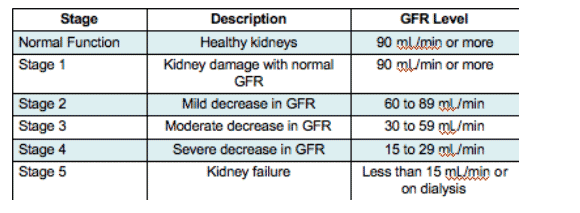
CKD was defined as a GFR <60.
Multivariate logistic regression was used to identify independent predictors of declining GFR from among factors significant in univariate analysis
Statistical Analysis. Data were analyzed using _2 or Fisher's exact tests for categorical variables. Continuous variables were compared using the Student's t-test or Mann-Whitney U test for normally and non-normally distributed variables, respectively. Bivariate correlation testing was also used to test the strength of association between GFR and other clinical variables. Significant variables were then entered stepwise into a logistic regression model in order to determine the best multivariate model.
The data set was analyzed using the SAS software package (Version 9.1, Cary, North Carolina).
RESULTS
671 persons were included in this analysis.
Mean age was 41 years
158 women (24%)
394 non-Hispanic White (59%), 198 African American (30%), 65 Hispanic (10%)
Mean GFR: 96.8 mL/min/1.73m2
-- 400 persons (60%) with normal kidney function (GFR >90)
-- 250 persons (37%) with stage 2 disease (GFR 60-89)
-- 21 persons (3%) with CKD (all with GFR 30-59)
By urine dipstick, 10% had presence of proteinuria and 1% had presence of glucosuria
9% of subjects had urine albumin > 30mg/dL by spot urinalysis.
Mean cystatin C was 0.90 mg/L
--19% of subjects had a cystatin C level > 1.0 mg/L.
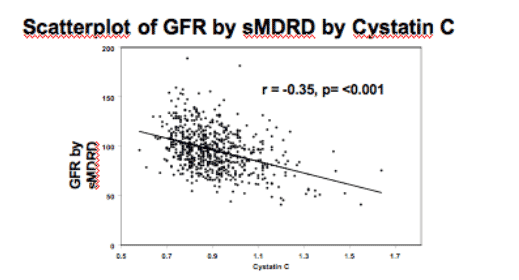
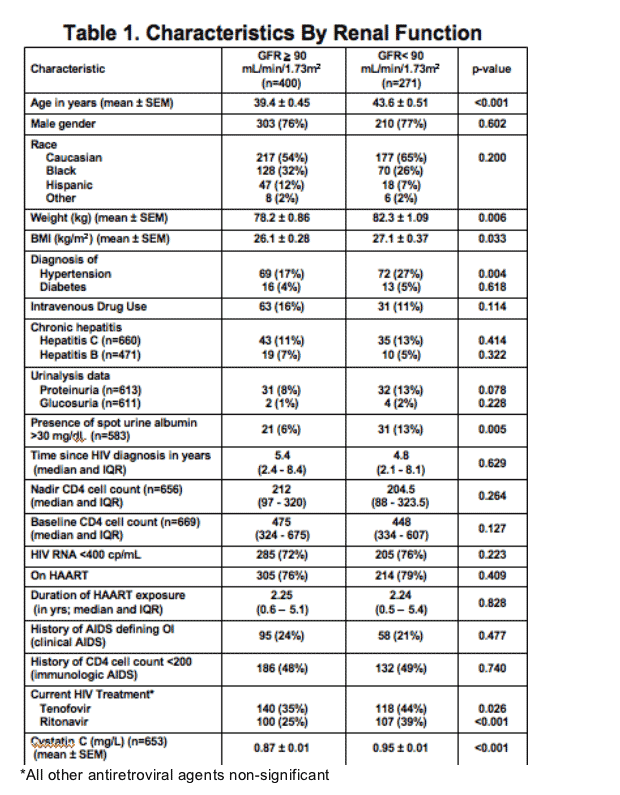
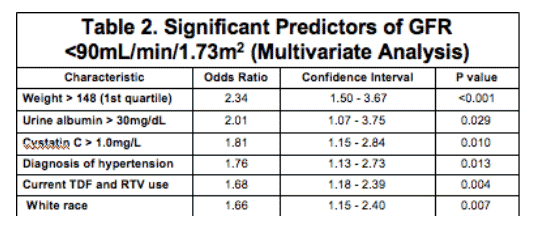
CONCLUSIONS
Despite a low prevalence of CKD among HIV-infected outpatients, there was a high prevalence of mild renal dysfunction
The prevalent reductions in GFR appear to be associated not only with traditional risk factors but also with antiretroviral therapy.
Cystatin C was well correlated to GFR in this HIV-infected cohort.
CKD is likely to become more prominent as patients age and are on long-term HIV therapy.
Limitations
Given that this evaluation was of only the baseline parameters, we may be limited by the cross-sectional design of this analysis. Evaluation of longitudinal data will clarify whether these findings represent a possible trend towards decreasing GFR with longer use of HAART, or if other factors (i.e. advancing age, further immune reconstitution) may outweigh any HAART-associated effects on GFR over time.
We were unable to capture complete cumulative antiretroviral history on clinic patients since many had initiated HAART much earlier through a different care facility or had been intermittently lost to follow-up.
Finally, the sMDRD equation has not been properly validated in the HIV-infected population. The SUN Study group is looking at the validity of this parameter in other analyses.
Recommendations
Clinicians should remain vigilant in screening for evidence of subtle declines in renal function in HIV-infected patients and treat modifiable risk factors for chronic kidney disease.
Additional research is warranted to evaluate risk factors associated with kidney dysfunction and determine other markers such as cystatin C to detect early renal dysfunction.
|
| |
|
 |
 |
|
|